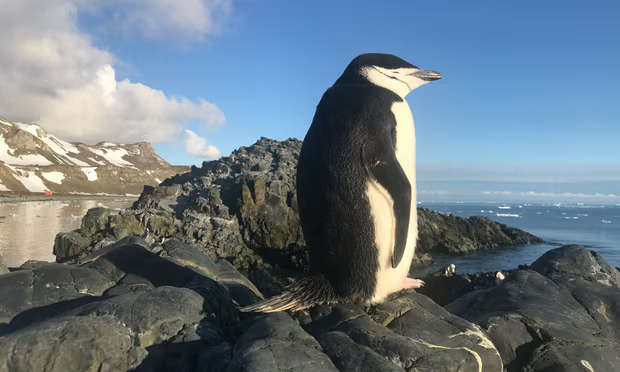Antarctic Avian Slumber: Discovering the Surprising 11-Hour Siestas of Birds in Antarctica
Adopting an unconventional sleep pattern marked by four-second naps throughout the night might sound like a torturous ordeal for humans, but for chinstrap penguins, it’s a fascinating adaptation, as revealed by recent research.
In their meticulous studies on King George Island in Antarctica, scientists have uncovered the remarkable sleep habits of these penguins, who indulge in over 10,000 fleeting naps each day. This peculiar sleep routine serves as a constant vigil over their nests, ensuring continuous protection for eggs and chicks from potential predators. In a feat of natural ingenuity, these penguins manage an impressive 11 hours of rest daily, all without succumbing to extended periods of uninterrupted sleep.
Lead researcher Paul-Antoine Libourel from Lyon Neuroscience Research Centre remarked, ‘Humans would find this sleep pattern unsustainable, but penguins not only endure it but thrive. Our understanding of sleep, it seems, is far more intricate and diverse than what traditional textbooks portray.’
In contrast to earlier research in the 1980s, which hinted at fragmented sleep patterns labeled as ‘drowsiness,’ the latest findings illuminate the persistence of this fragmented sleep throughout the entire day. Astonishingly, the penguins don’t appear to transition into deeper sleep during these moments of rest.
As highlighted in their recent publication in the journal Science, the researchers observed, ‘Sleep in breeding chinstrap penguins remained highly fragmented under all conditions and positions on land.’ This intriguing discovery suggests that these ‘microsleeps’ may serve vital restorative functions, challenging our conventional understanding of sleep. Importantly, the studied penguins exhibited the ability to sleep both while standing up and lying down.

While sleep is a widespread phenomenon in the animal kingdom, it exposes creatures to predation risks by compromising their ability to swiftly respond to the external environment. Libourel underscored, ‘Sleep is a fundamental aspect of animal behavior and is subject to the pressures of natural selection. Although much of the sleep research focuses on rats, mice, and humans, investigating diverse species sheds light on how environmental changes impact sleep dynamics.’
In their investigation, researchers delved into the behavior of chinstrap penguins in their natural habitat, employing electroencephalogram (EEG) monitoring and continuous video surveillance. The presence of microsleeps, identified through sleep-related brain activity and brief eye-closures, was a notable finding. Interestingly, a marginal intensification of sleep occurred around noon, a period possibly associated with diminished predation risk.
Chinstrap penguins exhibit a distinctive parenting strategy, with one partner safeguarding the nest for extended durations while the other embarks on feeding expeditions. However, prolonged sleep could potentially jeopardize their eggs or offspring, rendering them susceptible to predation by brown skua birds or other penguins.
The study focused on 14 penguins engaged in incubating eggs, selected from a colony of over 2,700 breeding pairs. The revelation that these birds partake in thousands of microsleeps lasting a mere four seconds is considered ‘unprecedented, even within the realm of penguins,’ as highlighted by the researchers.

Evidence from studies suggests that certain species maintain minimal sleep routines without apparent compromises to their wakeful performance. Notably, African bush elephants, averaging a mere two hours of sleep per day, often while standing, have been observed to endure up to 48 hours without sleeping, as indicated by a study.
Sexual dimorphism influences sleep patterns in some species; male fruit flies demand over 10 hours of sleep daily, while their female counterparts thrive on four hours, and surprisingly, can withstand less than 15 minutes of sleep without seemingly impacting their odds of survival.
Giant frigatebirds, embarking on months-long ocean migrations, allocate less than an hour daily for sleep while simultaneously navigating and hunting. Upon returning to their nests, they compensate with an extensive snooze lasting nearly 13 hours each day.
A paper published in the journal Sleep Advances disrupts the conventional perspective on sleep as an indispensable state for waking performance. The researchers emphasize, ‘Taken together, these systems challenge the prevalent view of sleep as an essential state on which waking performance depends.’
Reflecting on the data presented by Libourel et al., researchers Christian Harding and Vladyslav Vyazovskiy, in a related article published by Science, argue that this could be one of the most extreme illustrations showcasing the gradual accumulation of sleep benefits. They assert that the paper prompts reconsideration of the threshold at which sleep alterations begin to erode these benefits.
In conclusion, they state, ‘Demonstrating that this unconventional sleep pattern incurs no cost to the penguin would fundamentally challenge the prevailing interpretation of sleep fragmentation as inherently detrimental to sleep quality.

Hi there! Do you use Twitter? I’d like to follow you if that would be
okay. I’m undoubtedly enjoying your blog and look forward to new posts.